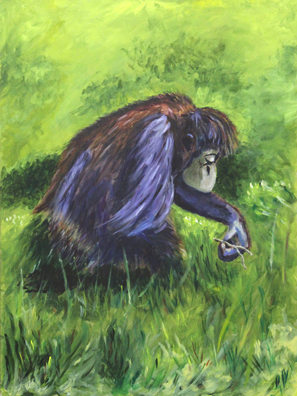Orangutan

A studious orangutan rendered in acrylic paint.
First of all, the pronunciation is "or-RANG-oo-TAN" not, as many people say "or-RANG-uh-TANG". Even Frank Buck, who yes, was a real person, and yes, trapped animals primarily in Asia, said "or-RANG-uh-TANG".
In Malay "orang" means "man" and "utan" (or "hutan") means "forest". Ergo, orangutan means "man of the forest".
Like most apes, orangs (as we will call them) are herbivores. But although they may also eat insects, they do not seem to eat actual meat (as chimpanzees sometimes do). Unlike the other Great Apes, orangs are usually solitary and live by themselves rather than in groups. The youngsters remain with their mothers five or six years before heading off on their own.
Orangutans have a larger arm span than gorillas or chimps, a span that often reaches 7 feet. This facilitates their lifestyle of which 90% is spent in the trees. Like gorillas they make new nests each night and can typically fashion a new one in about five minutes. Since orangs live in the rain forests, they keep their nets dry by constructing awnings or umbrellas from larger leaves.
One of the most contradictory bits information about orangs is how many species there are. Some books say there is only one species, Pongo pygmaeus and other divisions are subspecies. However, other sources follow naming conventions for separate species.
Orangutans are listed as critically endangered. The numbers given by various sources for the wild animals varies enormously from a high of 70,000 to a low of 15,000. The discrepancies are likely due to the rapid decimation of the species, which in a single decade can decline by 50%. Although some animals are hunted for meat, deforestation, primarily due to logging (much of it illegal) and farming, both which destroy the habitats is the chief danger for the species.
Orangs are among the most intelligent of the primates. They can learn sign language and have tool making skills. One orang was even able to pick the lock of his cage using a piece of wire.
The famous animal collector, Frank Buck, once caught an unusually large orangutan - or rather a group of natives caught the animal which they sold to Frank - by leaving a tub of drinking water under its tree. Once the animal began to rely on the water, the natives started spiking in arak which Frank called a native gin and is an anise liqueur similar to ouzo. They upped the dose until it would impart the characteristic euphoria and get the orang used to the taste. Then after an interval, they put in pure arak.
The orang spit the first mouthful out. But then he tasted it more gingerly and drank it down. After a while (and an attempt to climb back into his tree) the ape collapsed in an ethanolic stupor. The natives then loaded him into a cage and took him into Singapore where they knew the animal collectors hung out.
The animal was huge, and the natives hoped to get Frank and a group of Japanese collectors into a bidding war. They discussed their strategy openly not knowing that Frank, although not speaking Malay all that well, understood normal conversation. The headman was trying to get two thousand Straits dollars from Frank and kept stalling until one of his workers could locate the Japanese. Frank was willing to pay a thousand Straits dollars although he thought even that sum was too much.
The Japanese collectors couldn't be found and so the headman eventually agreed on Frank's price. Frank got a note that the Ringling Brothers Circus would buy the animal on the dock. This relieved Frank of the necessity of shipping the animal from San Francisco to Florida.
Unfortunately, Frank's goal of bringing 'em back alive was not always successful. The organutan contracted dysentery on the trip to America and died just before the boat docked. Enough such misfortunes could send an animal collector into ruin which - with a bit of help from the Great Depression - eventually happened to Frank. But then he found a writer who would help him put his stories into a marketable form. The book, Bring 'Em Back Alive was a success. It led to more books and then to movies, and - of course - to product endorsements.
References
Orangutans, Lynn Stone, Rourke, 1990.
Orangutan, Sally Morgan, QED Publishing, 2005.
Orangutans, Lynn Stone, Rourke, 1990.
"Orangutans", National Geographic.
"A Quest to Save the Orangutan", Bill Brubaker, Smithsonian Magazine, December 2010.
"Why are Orangutans in Danger of Becoming Extinct?", Orangutan Foundation International.
"On the Edge of Extinction", Sumatran Orangutan Socieity.
Bring 'Em Back Alive, Frank Buck with Edward Anthony, Simon and Schuster, 1930.
"How Does Deforestation Affect the Orangutans?", Scientific American.
Africa Screams, Bud Abbott and Lou Costello, Nassour Studios 1949. Despite the plot having Bud and Lou meet Frank Buck trapping animals in Africa, Frank worked primarily in Asia and never even went to Africa.